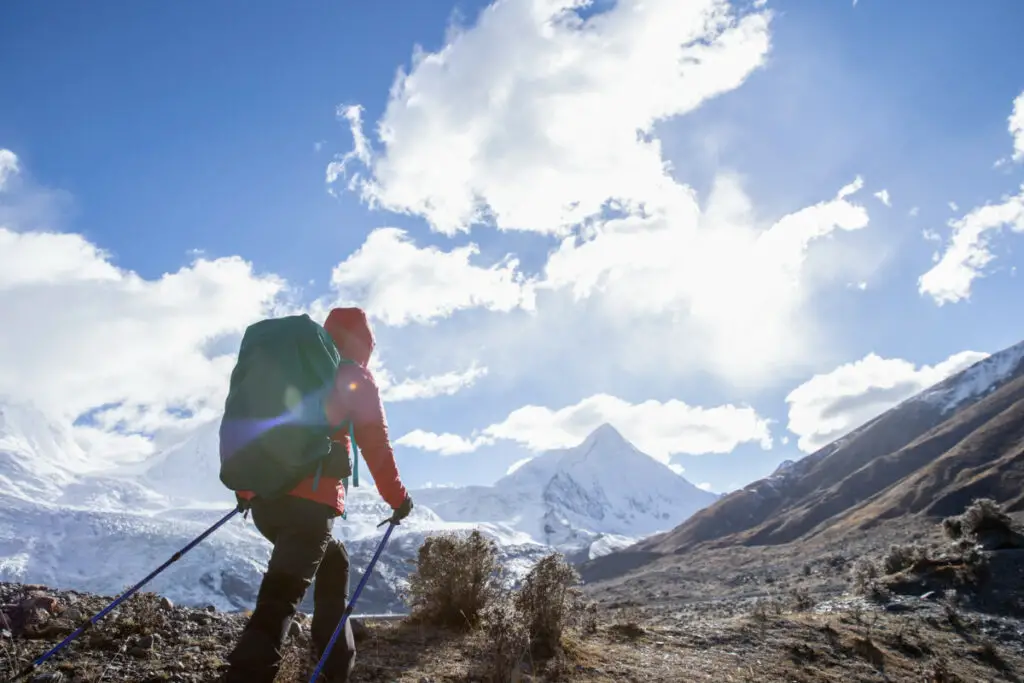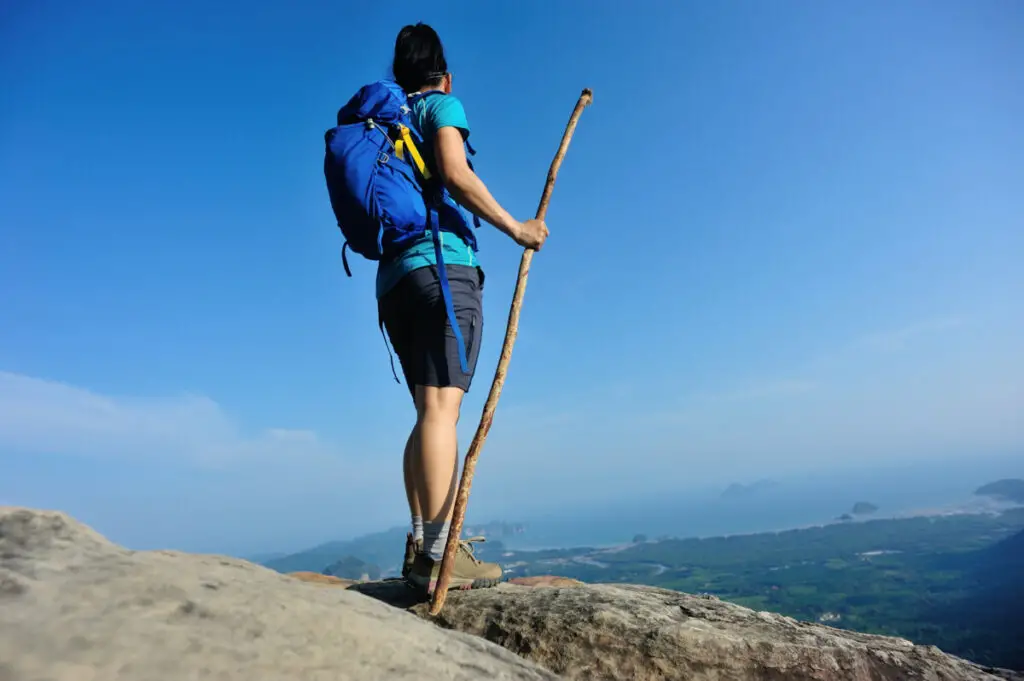
Hiking sticks, or trekking poles, are a popular topic of debate in the hiking community. Some avid hikers swear by them, while others insist that the poles only slow you down. So how helpful can hiking sticks actually be?
Hiking sticks can help protect hikers’ knees when descending steep hills, improve levels of power and endurance when ascending uphill, and provide extra balance on uneven terrain or during water crossings. On shorter hikes with little pack weight, hiking sticks may be unnecessary and cumbersome.
Basically, hiking sticks are the most useful on longer hikes with advanced terrain, or for people whose health warrants the extra physical support. As an avid hiker, I absolutely love the balance and power distribution that I get from using my trekking poles, especially during the winter and on steep hikes. In short, it’s all a matter of preference, but here are a few more details that may help you decide what works best for you.
Pros of Hiking Sticks

Hiking sticks are not strictly necessary for all hikers, but they do provide dozens of benefits.
Knee Protection
If you’ve ever hiked to the top of a mountain—which is totally worth the view—you’ll know that the best and worst part of the return trip is the descent. It’s nice to finally be going downhill instead of struggling uphill, but steep trails can be tricky to navigate without repeated, painful impact on your knees and ankles. Gravity is going to naturally pull you down the mountainside, so it’s incredibly useful to have hiking sticks to help manage the speed and impact of your descent.
Uphill Endurance
When you’re scaling a steep hill or mountain trail, your legs can get so tired that it drives you delirious! It’s hard to stay motivated when every thigh and calf muscle is shaking from the strain. Meanwhile, your arms are doing nothing, except perhaps shouldering a bag. Hiking poles allow you to leverage the unused muscle in your arms, pulling yourself upward with all four limbs and allowing you to redistribute your weight and your overall amount of energy.
Improved Posture
Hiking sticks have proven to improve spinal and shoulder posture in many hikers, since holding the poles helps you stay balanced and face upward, rather than staying hunched over under the weight of your pack. With corrected posture, hikers often find that it is then also easier to breathe deeply and regularly, helping the hike be more enjoyable and sustainable. This also strengthens the muscles that support the spine, which in turn will help decrease back pain.
Burned Calories
When hiking sticks are involved, you’re engaging your entire body in the activity. It’s almost as physically beneficial as swimming! With your arms and legs working together to help you conquer the trail, you’ll get trained and toned from head to toe.
Extra Protection
If you encounter poison ivy or stinging nettle, you can use your hiking poles to hold the plants out of the way as you pass. You can also use a hiking stick to test how deep a river or stream is if you need to cross one. Hiking poles can also be useful in the event that you encounter a wild animal. They won’t exactly hold off a charging bear, but they could help ward off smaller creatures. It’s like having an extension of your arm that can’t get hurt!
Blood Circulation
If you’re like me, your hands can get pretty swollen and numb if you hike with them at your side. Gripping your hiking poles and engaging your hands and arms in regular swinging motions will majorly improve your overall blood circulation, helping you avoid numbness or lightheadedness.
Cons of Hiking Sticks

As helpful as hiking sticks can be, there are a handful of drawbacks that can make or break your personal preference:
Cumbersome
Hiking poles can be limiting in some situations, especially if you’re accustomed to being pretty agile on the trail. In areas where you need to climb by hand or use rope assists, figuring out what to do with your hiking sticks or where to stash them can be a hassle. They also get in the way if you like to pause and grab snacks or take pictures, since leaving them dangling from your wrists isn’t ideal.
Extra Weight
If you’re already carrying a heavy backpack or other gear, having the extra weight of a hiking stick just might not be worth it for you. Some people prefer having a stick to help manage the weight, but others observe that it simply makes them tired faster. Using your energy quicker than you anticipate definitely detracts from the overall enjoyment of hiking.
Expensive
For hikers on a budget, good hiking sticks can seem pretty hard to financially justify. Well-made sets run anywhere from $50 to $200. Of course, if you prefer using them and you hike a lot, it’s well worth the price to invest in durable ones. But if you’re just beginning, and don’t want to use flimsy, cheap poles, the cost can be frustrating or intimidating.
How and When to Use Hiking Sticks

Using hiking sticks correctly is all about sizing and timing. Most trekking pole manufacturers will have recommended measurements for how tall the poles should be based on your height. I prefer having mine at elbow height, but some people like having them at armpit height or even as high as shoulder height. The length of the pole corresponds to the length of the hike: if you’re just going on a day hike, short, lightweight poles will be perfect; if you’re going on a long, intense hike or a multi-day backpacking trip, a medium or long pole will be more helpful.
To use the hiking sticks, adjust them to the appropriate height for your body type, then slip your wrists through the straps. Gently make an ‘O’ shape with your thumb and index finger around the handle, letting your hand rest in a loose grip. The straps will help distribute your weight and prevent you from straining your hands from a tighter grip, especially on longer hikes. Plant the poles in front of you one at a time, before each step and in coordination with how you would use your feet. If you’re using a single hiking stick. you’ll likely prefer having it in your dominant hand to help lead your body up the hill.
The ideal situations for using hiking sticks are those that involve difficult or unusual terrain. For instance, I recently used my poles to hike a 3-mile, snowy trail. Since it was during the late winter months, the snow had begun to melt in some places and had repeatedly refrozen in other places. This made the trail both muddy and icy, which meant that no matter where I put my feet, I had the danger of slipping. There were several times that I was able to save myself from plunging into the snow by simply anchoring my poles and regaining my balance. For winter hiking, I’d highly recommend using poles with wide-grip base attachments.
Hikers on all kinds of forums will rave to you about the life-changing benefits of using hiking sticks, while others will insist that it makes no difference whatsoever. The best way to decide what you personally prefer is to try them out on a few short trips through varying terrains. You’ll either fall in love with them, as I did, or discover that you’re happier trekking with minimal gear. Either way, you’re hiking, so life is good.
| Do you like Using Hiking Poles? | |
| Yes!!! | 74% |
| No | 18% |
| I have never used a hiking pole | 7% |

